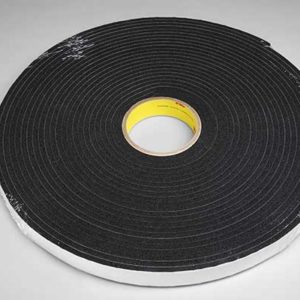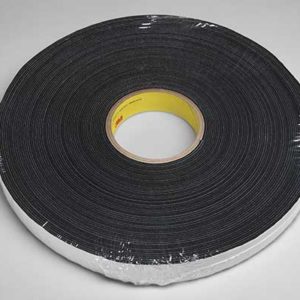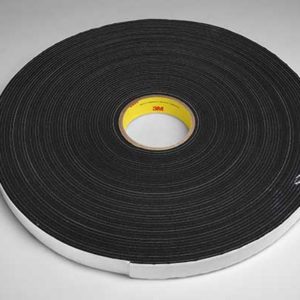Vinyl - PVC - Nitrile Foam
Vinyl – PVC – Nitrile Foam
Best in applications where impact cushioning is a must and long-term outdoor exposure is expected
PVC Vinyl closed cell foam comes in several densities of Black or Gray and in numerous thicknesses. PVC Foam can be supplied with or without adhesive.
Typical applications for PVC foams are seals and gaskets used to seal out air, dust and light moisture.
PVC foams are resistant to most solvents and chemicals and easily fabricated to meet your specific application.
Showing all 11 results
-
1″ x 18 yd. x 250 mil Black Vinyl Foam Tape
-
1″ x 36 yd. x 62.5 mil Black Vinyl Foam Tape
-
12″ x 18 yd. x 250 mil Black Vinyl Foam Tape
-
12″ x 36 yd. x 62.5 mil Black Vinyl Foam Tape
-
14″ x 36 yd. x 62.5 mil Black Vinyl Foam Tape
-
24″ x 18 yd. x 250 mil Black Vinyl Foam Tape
-
34″ x 18 yd. x 250 mil Black Vinyl Foam Tape
-
34″ x 36 yd. x 62.5 mil Black Vinyl Foam Tape
-
38″ x 18 yd. x 250 mil Black Vinyl Foam Tape
-
38″ x 36 yd. x 62.5 mil Black Vinyl Foam Tape
-
Custom Converted Black Vinyl Foam Tape
Vinyl Nitrile Foam
Vinyl nitrile (PVN) foams, a high-quality plastic, and rubber blended, closed and semi-closed cell foam, are practically indestructible, and they are outstanding products when it comes to cushioning, shock absorption, and dampening.
This foam material can be die-cut to consumer requirements.
Vinyl Nitrile Foam is a polymer blend of PVC and Nitrile material. PVN foam is soft and flexible and is naturally a thermal insulator, shock/impact absorber, sound deadening and flame retardant. Due to its closed cell construction, the foam is an ideal sealing and gasket material against moisture, liquid, and gas. Vinyl Nitrile foam can be easily fabricated with adhesive or without adhesive.
Vinyl nitrile foams are among the most functional foam materials within the market. Vinyl nitrile foams are utilized in more outside applications compared to other materials. It can be coated with aluminum foil for superior heat insulation and energy-saving properties. The foam is available for a wide range of applications including HVAC seals and gasket, roofing insulation, duct liner and wrap, general sealing and insulation for automotive, wall sound absorption, foam yoga mat, and building/construction industries.
Properties:
- Closed cell structure
- Flexible and lightweight
- High thermal efficiency
- Sound absorption properties
- Flame retardance
- Low water absorption rate
- High water vapor diffusion resistance
- Resistance to oil and grease
Benefits:
- Strong thermal and acoustic insulator
- Perfect water and moisture barrier
- Excellent shock and impact cushioning
- Versatile for various of applications and usage
- Available for adhesive backing and foils
- Applications:
- HVAC system
- Construction seals
- Foam seal strip and gasket
- Pipes, ducts, and tanks
- PVC Nitrile foam tapes
- Protective padding
PVC (Vinyl) Foam
Vinyl Foam Tapes and Materials, also known as Polyvinyl Chloride (PVC) Foam, are lightweight closed-cell foams that are chemically resistant and affordable. These adhesive foam tapes are typically used as gaskets to seal out light, air, dust, dirt, and noise. It can also be designed for general-type mounting. It provides good cushioning, remains flexible, is easily conformable and resistant to weather and solvents.
PVC foams was once a core material in the 70’s for marine applications. They needed a low-density, consistent, moisture resistant material and it was greatly refined over the years. PVC foams have good physical properties when compared to other foams of similar density.
Many PVC foam manufacturers are interested in reducing the density of their products to reduce costs and achieve lighter weights. Properties, however, are very dependent on the thickness of the final foam product. Vinyl Foam Tapes are available with or without adhesive and various densities, from low Density, Medium Density, to High Density.
PVC foam resists weathering and is often laminated with an adhesive to create various types of foam tapes.
Double coated adhesive foam tapes will seal and cushion, dampen vibrations and withstand high-temperature fluctuations. They can be used to bond to irregular, rough surfaces both permanently or temporary. Double-sided adhesive PVC foam is ideal for mounting nameplates, indoor signage, trim panels or wall corner protection.
Features and Benefits of PVC Foam:
- Closed cell structure
- Seals out air, light, moisture, dust, and dirt when compressed at least 30%
- UV resistant
- Resists most chemicals, acids, and solvents
- Service temperature range of -40°F to 200°F
- Fire resistant
- Reduces Sound Transmission
- Contains Intrusive Noise
- Improves Health and Safety
- Provides Thermal Insulation
PVC foam is a polymer comprising two or more networks of PVC and Polyurea. The relationship regarding these types of polymers provides the foam has its own distinct qualities and cannot be detached unless the chemical bonds are broken. It can be thermoformed even though the foam is a thermoset foam. Also, it is resistant to many solvents including styrene and most fuels, yet is compatible with most adhesives and laminating resins. PVC foam is a closed-cell foam and has very low moisture absorption. It is self-extinguishing and will not rot. Other hereditary properties include outstanding fatigue life and excellent bond strength when combined with adhesives or resins.
PVC foams can be produced in either rigid or pliable materials. Rigid PVC foams, sometimes referred to as crosslinked, will have higher heat and solvent resistance than the pliable types of foam materials. Shear strain to failure for stiff PVC foam materials will vary with a density of 12-30%. Pliable PVC foams have a higher shear elongation to break, typically more than 40%. However, pliable foam materials have lower physical properties, heat and solvent resistance for a given density.
Rigid Marine-grade PVC foams can be processed up to 180F and can be used continuously for up to 160 degrees Ferehight. Very specialized grades of PVC foams can be processed up to 250 degrees Ferehight and used continuously up to 190 degrees Ferehight. They refrain from getting brittle during cold temperatures and can be used in cryogenic applications. Pliable PVC foam materials can be processed up to 150 degrees Ferehightand used continuously at 120 degrees Ferehight.
PVC foams come in a variety of densities from 3pcf to 25 pcf. Unlike polyurethane foam, Vinyl Foams have a more involved manufacturing process and is not a 2 component pour. The raw ingredients are carefully mixed under certain controlled conditions and dispensed into a solid mold. The mold is then sealed, placed in a large press and heated while remaining clamped shut. When this process is completed, a slab of solid material is taken from the mold.
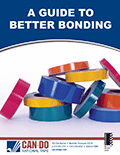 Download our free Guide to Better Bonding
Download Now
Download our free Guide to Better Bonding
Download Now
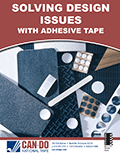 Download our free Guide to Solving Design Issues with Adhesive Tape
Download Now
Download our free Guide to Solving Design Issues with Adhesive Tape
Download Now

